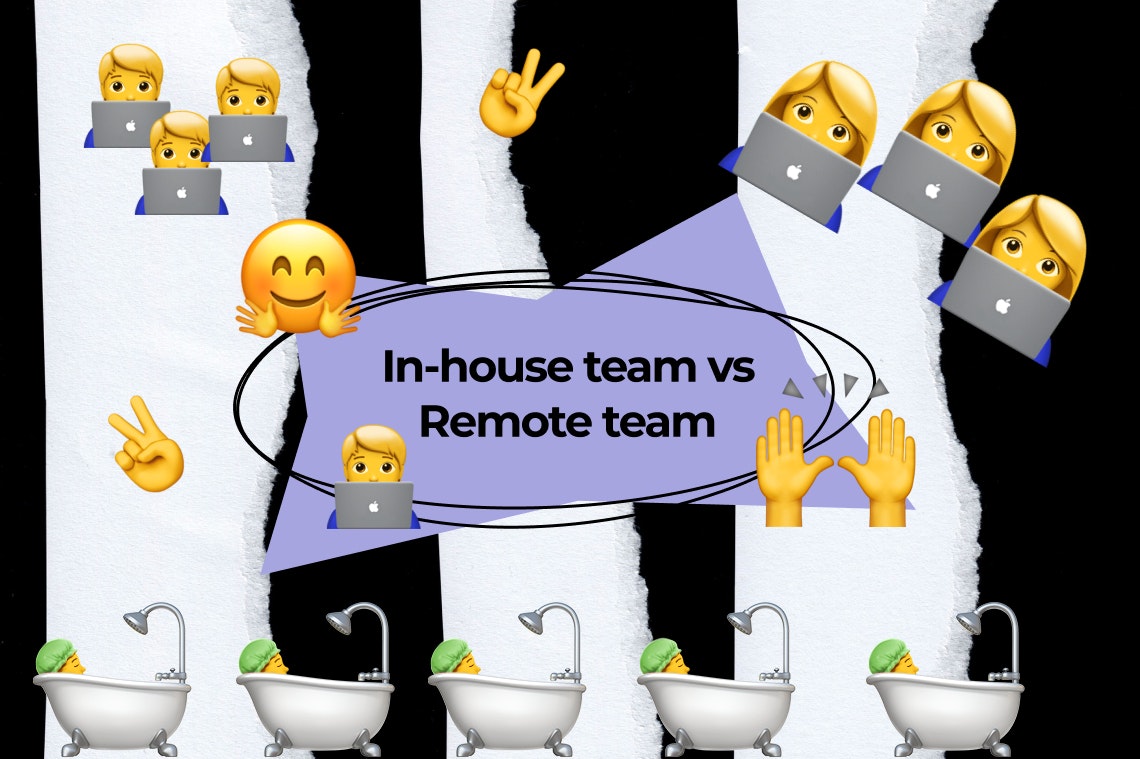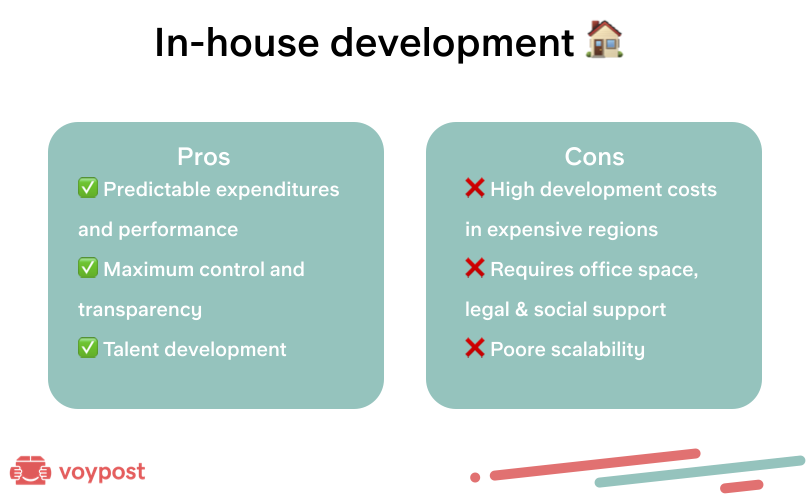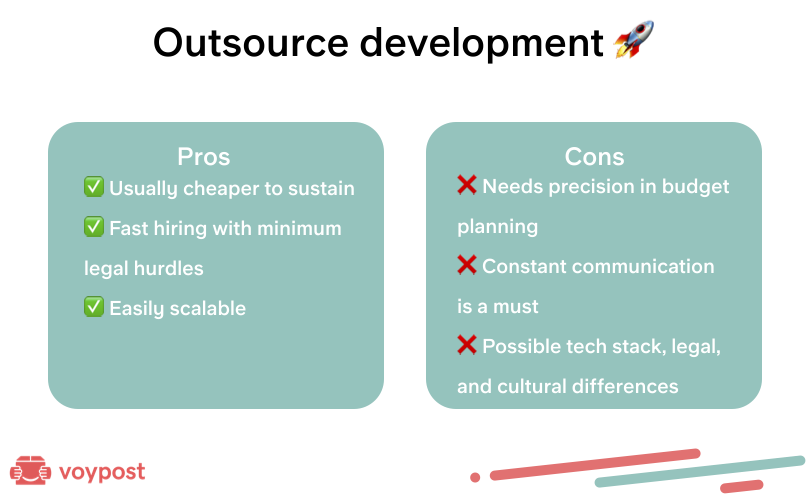In-house team vs remote team: which software development team model to follow in 2022
What is better: in-house or remote? Check out this comparison between In-house vs Outsourcing Software Development team to choose the right one for your project.
Natali Savenko
April 02, 2022
9 min read

Business owners usually aim for the best balance between expenditures, the speed of product delivery, and quality. Achieving perfection to make all the circles overlap on this Venn diagram is sometimes impossible, so in this particular article, we aim at explaining some team composition tips.
Specifically, in-house vs outsourcing software development teams.
The right team composition would definitely improve the performance of your company.
In-house team: advantages and disadvantages
“In-house” refers to the teams that work directly for a given employer, as opposed to third-party service providers. It is not unheard of that a business owner to know every in-house developer in person.
In-house development teams are never assembled in a short time. A business owner themself might gradually hire developers one by one if the project is at the stage of conception. In the case of mature business ventures, the process would be carried out by a whole Human Resource department and take weeks or even months depending on the niche and market saturation.

In-house team pros and cons
✅ Predictable expenditures and performance
✅ Maximum control and transparency
✅ Talent development
❌ High development costs inexpensive regions
❌ Requires office space, legal & social support
❌ Poore scalability
Advantages
The past performance of an in-house team provides clear data for software development planning; the budgets are, likewise, predictable in the case of tasks that were completed before.
In-house software development teams are perfect for those leaders who prefer to communicate with their team in person and be able to select and support talented members.
The team, on the other hand, is free to voice out their concerns and suggestions directly to chief executives, visit every meet-up in person, provide first-hand reports, and otherwise contribute to the project development.
If all the departments focused on the same project are in the same building, direct communication between the members speeds up development and improves the general quality of digital products.
As for talent development and internal labor market inside a given company, the loyal workers who know the company inside out and share its values are certainly more motivated and possibly more reliable than newcomers.
Disadvantages
The salary difference between the country of origin of a given team and an economically attractive region might be the least of financial concerns connected to sustaining an in-house team. Consider office space rent, security, bills, paid leaves, insurance, and other expenditures.
An in-house team is a no-go for startups, which are known to start from a humble basement or garage. Hiring competent developers takes precious time while speed-to-market means everything.
In-house development teams are rarely resorted to when the workload is irregular and inconsistent. Dynamic organizations that often scale their teams up and down would benefit from remote teams the most.
Remote team: advantages and disadvantages
Workload challenges, extraordinary tasks, financial difficulties – are some of the reasons why companies around the globe outsource development.
What is outsourcing? As opposed to “insourcing”, it refers to production of goods (or software services) outside of the main facilities.
Ordering production from another company across the street is still outsourcing just like doing it overseas. To distinguish these subtleties, the meaning of “outsourcing” is narrowed to “nearshore” or “offshore”.

Remote team pros and cons
✅ Usually cheaper to sustain
✅ Fast hiring with minimum legal hurdles
✅ Easily scalable
❌ Needs precision in budget planning
❌ Constant communication is a must
❌ Possible tech stack, legal, and cultural differences
Advantages
The US, the UK, and the European Union are known to be the highest paying regions, as they are the most economically developed. For that reason, there is a noticeable salary gap between the developers of the North Atlantic and the rest of the world.
While the level of IT experts in developing countries matches or exceeds the level of their colleagues who live in thriving economies, the price of their labor is much lower. The diversity of talent and massive savings are the main reasons why businesses lookout for remote development teams.
Scalability is another indubitable advantage of remote teams. In the case of per project pricing model, a product owner does not even have to worry about the team size. As soon as the job is done and the backlog is empty you don’t have to invent a new task to keep them occupied or fire any of them.
The companies that specialize in IT outsourcing services either serve as intermediaries between a product owner and a contractor or provide their own teams.
Disadvantages
The time zone difference is an obvious communication barrier between the teams. It is neutralized with relative ease: the parties negotiate the meeting schedule in such a way that time is convenient for both of them.
Neither is language a serious hindrance in communication because professional developers, team leads, and project managers have at least intermediary mastery of a customer’s native language.
Legislation differences, on the other hand, pose a more serious threat to the relation of two parties. For that matter, every software outsourcing company should have a package of documents that regulate further cooperation. Property rights, software licenses, data protection, and privacy, international standard compliance, etc.
Of course, the core and remote teams have to agree upon the use of a software development model and the technology stack. Pay attention to product documentation because one way or the other, the project is going to be taken over by the core team or another contractor.
Outsourcing Development Process via Agency
Rather than picking candidates through platforms and tech marketplaces, product owners may hire a development team via a broker company that keeps in touch with multiple software services.
Apparently, the broker will charge a fee for their services, so if it is possible to manually look through the search engine results related to the task.
Hybrid approach
Why not wisely adopt both team composition approaches instead of performing a complex SWOT analysis of pros and cons of insourcing vs outsourcing?
Outsource non-critical tasks like Quality Assurance, audit, or front end development to experienced remote teams. Retail businesses might order web development outsourcing or application development outsourcing to take their venture a notch higher.
If a certain service is not fully outsourced, the term used is Team Augmentation.
In-house software development teams can be expanded or complemented with this approach. Software development does not rely on geographical positions of the teams involved, thanks to the Internet, so a product owner gets to retain all the benefits of keeping an in-house team and the benefits of outsourcing at the same time.
Staff Augmentation vs Other Models
To reiterate, keeping an in-house team resolves the following concerns: privacy and security of product-related information, personal development, and the ability to promote/reassign loyal workers and direct in-person communication with every team member.
Whenever a question, how to outsource software development in this case, arises – staff augmentation is the best choice.
A product owner personally overlooks the process and approves each additional remote member of their augmented team. They can be sure that each remote member of the augmented team will be focused on their project full-time, which cannot be said about the outsourcing model. In the latter case, one remote team might carry out several projects for different clients in parallel.
Remote employees are not treated as a separate entity; they are integrated into the core team so that a PO can closely communicate with their core team leader as usual. The in-house team lead, in turn, manages remote engineers.
No questions about intellectual property rights arise between a product owner and a service provider: the rights belong to the owner and the core team.
And the pricing model of staff augmentation is simple and straightforward.
How to Make the Right Choice for Your Business
Choose in-house team if:
You can afford the time and related expenditures to fully employ every necessary member;
Skilled engineers are abundant in the vicinity;
You prefer to select every newcomer personally (or at least approve the selection) and nurture close relations with the team.
Choose remote team if:
Software development is not the core specialization of your business;
You don’t yet have an in-house IT service department;
The costs of acquiring and sustaining an in-house software development team are prohibitively high;
The task at hand is highly technical and no expert teams are available nearby.
Choose staff augmentation if:
You already have an in-house team and want to scale in one of the following ways: add a whole new division, increase the number of specialists in an existing department, or hire a single expert (either to train the in-house team or work full-time);
You want to test the performance of remote experts and stay flexible at the same time;
You are attracted by the similarities between the in-house team model and staff augmentation model and want to make best use of the advantages of both (direct communication, talent abundance, cost reduction).
Both staff augmentation and a fully remote team will work if you need to deal with a seasonal/situational workload spike.
Outsource Your IT Product to Voypost
Consult our specialists on the model that would suit your business best.
Ensure that we are the right software development vendor for the task at hand by reviewing our use-cases or talking to our Solution Architect.